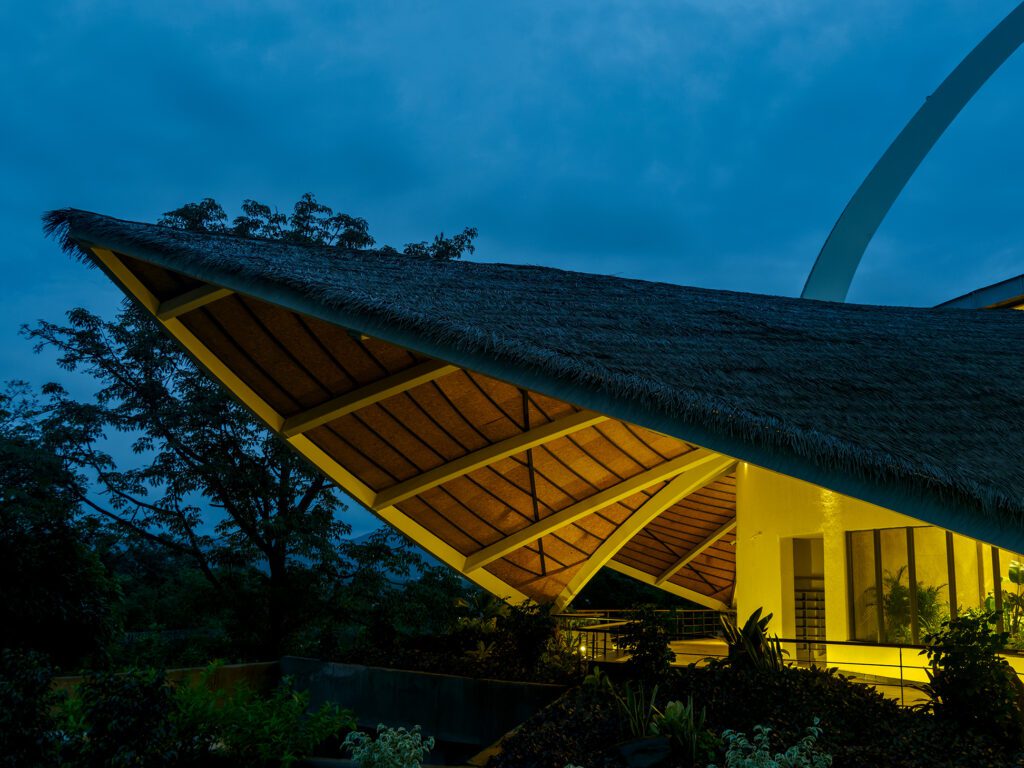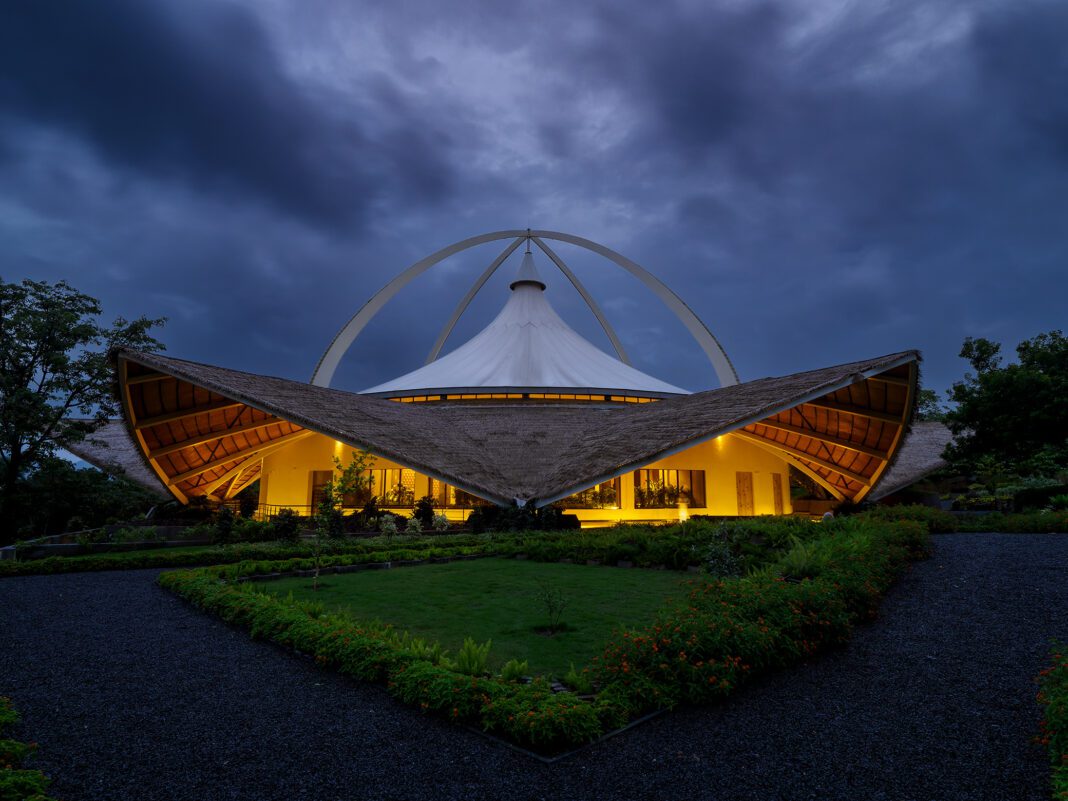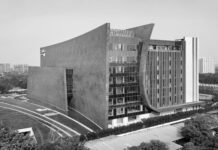The Swastik Wellness Retreat in Kudje, Maharashtra, is a holistic sanctuary nestled in the serene Peacock Valley, harmonising seamlessly with the natural beauty of its surroundings. Overlooking the tranquil backwaters of Khadakwasla Lake and the majestic Sinhagad amidst the Sahyadri mountain range, Swastik is more than just a physical space — it is a spiritual haven that invites individuals to explore and embody the core dimensions of life.
It is equipped with state-of-the-art audio-visual systems, and hosts spiritual activities and rituals such as meditation, chanting, yoga, lectures, and gratitude sessions, fostering peace and personal growth. Encircled by Nakshatra Van, a cosmic zodiac garden, the space offers an ideal setting for transformative experiences, promoting serenity and self-discovery amidst nature’s tranquillity.
Manish Banker, Founder and Principal Architect of TAO Architecture Pvt Ltd and Dhananjay Dake, Creative Director of Construction Catalysers Pvt Ltd highlight the key sustainable features, emphasising how the design integrates natural light while balancing functionality with environmental consciousness.

Cosmic Connection
At the heart of the retreat lies Dhyan Vihar, a sprawling column-less space covering over 80,000 sq ft (7,432 sq m), designed as a symbol of inner connection. Its circular, lotus-like design represents growth, harmony, and introspection, with the central meditation space symbolising the Garbh Gruha, or spiritual core.
The rising conical form leads individuals inward, while the surrounding gardens and walkways create a seamless connection with nature, fostering harmony and tranquillity. The hall’s design incorporates sustainable and functional elements which aids natural ventilation. Petal-like extensions over the Pradakshina Path, providing shade and shelter, mirror the form of a blooming flower while encouraging introspection.
Serene Symphony
The design of this structure features a tensile fabric roof, supported by four steel beams at the top and secured around the edges by an inner ring beam, which rests on RCC columns at the base. Spanning 128 ft in dia, the cone-shaped roof rises 88 ft, creating an unobstructed space beneath. The steel arches, chosen for their tensile and compressive strength, manage both the fabric’s tension and external loads, ensuring stability while maintaining minimal deflection. Supported by an outer ring beam and eight columns, the structure ensures openness and fluidity, fostering a tranquil environment ideal for meditation and gatherings.
The process started with finite element analysis, where elemental forces were identified at the first level. Using this global model, individual structural components such as arches, the base, and the ring were designed by extracting specific forces. Once the structural design was finalised, shop drawings were prepared to ensure precise fabrication. Automated cutting and the computation of developable surfaces further streamlined the process, ensuring high accuracy in execution.
Maintaining the curvature of the arches while meeting structural load requirements posed a key challenge. The initial design did not align perfectly with pure compression forces, necessitating slight modifications through engineering optimisation. Refining the arch while preserving its sleek proportions required additional computation, but the adjustments successfully met the intended design. The final structure was fabricated using CNC machines and advanced welding techniques, resulting in a seamless, jointless single-piece arch.
The steel arches are designed to support the fabric’s load while highlighting the graceful form of the steel frame. These structures offer flexibility, lightness, and expansive, uninterrupted spaces with minimal supports. In this design, the fabric symbolises the petals of a blooming flower, emerging from the core. The precision in erecting the 28 m high with a 33 m dia, ensured structural integrity, maintaining the circular geometry and balance of the design while allowing the roof to retain its elegant, flowing form.

Sustainable Sanctuary
Dhyan Vihar incorporates two primary materials: sleek, strong steel and a high-quality, recyclable membrane imported from Germany and fabricated in India. The membrane ensures a uniform lux level inside, maintaining balanced natural light during the day and an even glow at night. Both the materials are fully recyclable — steel can be repurposed or melted down, while the membrane can be returned to the factory for recycling — making the structure nearly 100 per cent sustainable with minimal waste.
The design integrates multiple sustainable strategies to minimise energy consumption while maintaining a serene and functional environment. Passive cooling and ventilation systems, including a misting system, regulate humidity and temperature for year-round comfort. The surrounding Zen garden serves as a natural cooling system, cooling the air before it enters the hall and allowing hot air to escape through the top.

The lightweight, translucent roof filters abundant daylight into the space, creating a soft, diffused light that enhances the tranquil atmosphere and reduces the need for artificial lighting. Large overhangs provide effective shading and minimise heat gain, while strategically placed openings facilitate natural cross-ventilation and, combined with a frameless roof-ceiling structure, create a tranquil space that fosters introspection and reduces reliance on energy-intensive systems, ensuring a pleasant and energy-efficient indoor environment.
Incorporating passive cooling, natural lighting, and acoustically sensitive surfaces, the project creates a serene, energy-efficient space that enhances meditation and reduces reliance on mechanical systems. The marble floor, combined with the breathable air flowing through the structure, creates a cocoon-like atmosphere that invites deep reflection.
Sustainable design features such as universal accessibility and a focus on human-centric spaces ensure that the building caters to all seekers. Eco-friendly initiatives, including natural ventilation and the use of strategic vegetation, work together to create a comfortable, energy-efficient environment, reinforcing the project’s commitment to sustainability.
Fact File
Project Name: Swastik Dhyan Vihar, Kudje
Client: Nyati Foundation
Architect: TAO Architecture Pvt Ltd
Structural Consultant & Fabricator: Construction Catalysers Pvt Ltd
Project Management: Nyati Group
Supplier: Ganga Iron & Steel, Sandip Steels, & Maharashtra Sales Corporation
Tonnage: 608 tonne
Status: Completed
Quote:
“Swastik, with its intricate blend of natural beauty, spiritual symbolism, and functional design, seeks to create a nurturing environment where individuals can engage with the essential elements of life for holistic well-being. The simplicity of its architectural solutions emerges from a complex interplay of materials and their juxtapositions, all centred around maintaining the silence of space as a core focus.”
– Manish Banker, Founder and Principal Architect, TAO Architecture Pvt Ltd
“From concept to realization, the meditation hall exceptionally blends architecture and engineering, where structure and light dissolve into a spiritual experience. The ethereal interplay of daylight and artificial illumination creates an almost invisible form, enhancing the sense of serenity. Steel provides strength and elegance, while the translucent membrane ensures a uniform glow, blurring boundaries between space and light.”
– Dhananjay Dake, Creative Director, Construction Catalysers Pvt Ltd
– Vanshika Raigaga





